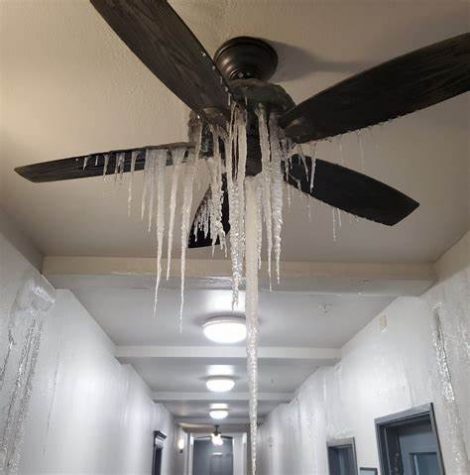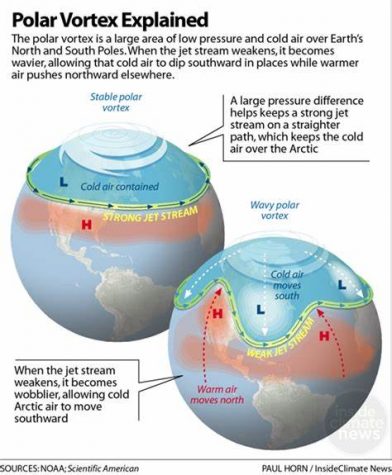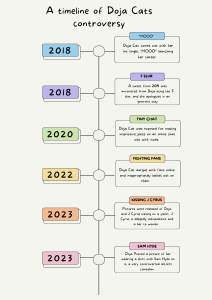Climate Change: A Hot (and Cold) Topic
March 4, 2021
There’s snow denying that 2021 has given us a rather chilly welcome. Take a look at this frozen ceiling fan– can you guess where this picture was taken? Dallas, Texas. This winter has been unusually brutal for the country, and especially vulnerable Texans: the single-digit cold took out the power for many across the Lone Star State, causing panic, suffering, and, unfortunately, even hypothermia-related deaths.
In the Midwest, we’re accustomed to the snowy cold, but even here, this winter has been a pest. Knee-high snow accumulation and finger-numbing temperatures have caused consistent cancellations and forced us to stay inside and off the roads.
In the first three weeks of February, the district used up all 5 of its calamity days, and delayed school on multiple occasions. JA Superintendent, Gary Chapman, gives insight on how he determines if a calamity day needs to be used due to dangerous weather.
“The first thing that runs through your mind,” he says, “is can you get kids to school safely…and can you get everyone home safely. We’re driving the roads at 4:15, 4:30, evaluating the conditions, talking to the area’s transportation coordinators and superintendents…we get a lot of good data.”
Chapman, who has been Alder’s superintendent for 10 years, also compares this winter’s weather to previous years.
“The past two years have been mild winters.” He says,” I don’t even know if we reached five [calamity] days.”
So, the question lingers: What has changed in the past few years that might be responsible for this unusually cold weather across the globe?
Climate change. Although these frigid months have been molded into an argument for climate change skeptics to discredit global warming, this argument is easily burned.
Firstly, it’s important to know the difference between weather and climate. A dull, rainy Wednesday in Seattle would fall into the weather category– the atmospheric conditions of a place at a certain time. On the flip side, climate is the observed conditions and patterns of the atmosphere over a much longer period of time; hence why a few weeks or even months of cold weather can’t disprove decades of changing climate. (Similarly, you wouldn’t categorize LeBron as a bad player just because he had one bad game; you’d look at his whole career to make a fair judgement.)
And although it can’t prove global warming exists because it’s only a weather snapshot, ironically, the biting cold and heavy snowfall we’ve been experiencing has strong ties to our warming planet.
There’s substantial science behind this theory, but to summarize:
- With the planet’s atmosphere getting warmer, bodies of water evaporate at a much quicker rate, adding more moisture into the air than normal. When the air is super cold in the winter, it turns moisture into snow; this could explain the consecutive days of deep snow accumulation this winter.
- Now bear with me, this next theory is a little bit more complex. On the upper part of our globe, there’s a jet stream: a cold band of winds that travels from west to east (planes fly in this to travel quicker). The jet stream separates the cold air from the Arctic, and the warm air from the middle latitudes. This temperature difference makes the jet stream strong and sturdy. Now let’s add global warming to the mix. With ice caps melting, and the temperature rising in the Arctic, the jet stream is no longer sandwiched by the cold air on top and the warm air below– it’s just a hot mess on both sides. The jet stream then becomes super unstable, and allows it to bend and stretch its path (this explains why Chicago is buried in snow, but also why southern states like Texas have been suffering as well).

Imagine your house was on fire. Would you wait a few years to call the fire department? No, you’d act immediately and without hesitation. Climate change will continue to kill our planet and threaten our livelihoods if we don’t actively pursue solutions to the problems we have created.
UC Davis formulated a helpful list of ways you can begin your path to an environmentally-friendly lifestyle: Use a reusable water bottle, walk or bike instead of drive, vote for green initiatives, grow your own food/buy organically, reduce, reuse, recycle, etc. Following these tips will ensure that you’re doing your part to combat our warming planet, hopefully helping us avoid future climate change-driven weather similar to what we’ve been experiencing lately.








